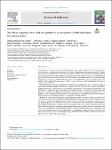The silent majority: Pico- and nanoplankton as ecosystem health indicators for marine policy
| dc.contributor.author | McQuatters-Gollop, A | |
| dc.contributor.author | Stern, RF | |
| dc.contributor.author | Atkinson, A | |
| dc.contributor.author | Best, M | |
| dc.contributor.author | Bresnan, E | |
| dc.contributor.author | Creach, V | |
| dc.contributor.author | Devlin, M | |
| dc.contributor.author | Holland, M | |
| dc.contributor.author | Ostle, C | |
| dc.contributor.author | Schmidt, K | |
| dc.contributor.author | Sheppard, L | |
| dc.contributor.author | Tarran, G | |
| dc.contributor.author | Woodward, EMS | |
| dc.contributor.author | Tett, P | |
| dc.date.accessioned | 2024-05-08T15:20:04Z | |
| dc.date.available | 2024-05-08T15:20:04Z | |
| dc.date.issued | 2024-02-01 | |
| dc.identifier.issn | 1470-160X | |
| dc.identifier.issn | 1872-7034 | |
| dc.identifier.other | 111650 | |
| dc.identifier.uri | https://pearl.plymouth.ac.uk/handle/10026.1/22475 | |
| dc.description.abstract |
A healthy marine ecosystem is a fully functioning system, able to supply ecosystem services whilst still maintaining resilience to human-induced environmental change. Monitoring and managing the health of resilient marine ecosystems requires indicators that can assess their biodiversity state and food web functioning. Plankton are crucial components of pelagic habitats, occupying the base of the pelagic food web. Larger plankton have long been used to monitor ecosystem productivity and biodiversity due to their identification via traditional light microscopy. In contrast, the regular monitoring of pico- and nanoplankton (<20 µm; hereafter called “tiny plankton”) only started with the development of flow cytometry techniques, which has limited their inclusion as ecosystem health indicators. Four UK plankton surveys have sampled and identified these tiny plankton for up to 14 years, providing an opportunity to test their suitability as indicators of ecosystem state. We investigated six groups of tiny plankton, including heterotrophic nanoeukaryotes, photosynthetic nanoeukaryotes, photosynthetic picoeukaryotes, and Synechococcus cyanobacteria, and two groups of heterotrophic bacteria. Flow cytometry and light microscopy data from an inshore Western English Channel station revealed that 99.98 % of plankton abundance and 71 % of plankton biomass was derived from tiny plankton cells too small to be quantified accurately under a light microscope and thus not adequately considered in assessments of pelagic habitats. Different UK marine and coastal regions showed consistency in peak abundances of these tiny plankton. We used a novel wavelet coherence method to identify time-based relationships between tiny plankton and environmental variables linked to human pressures. Relationships were found between nitrogenous nutrients and all tiny plankton groups, most commonly at sub-annual to annual time scales. Photosynthetic picoeukaryotes, heterotrophic nanoeukaryotes, and HNA-bacteria were associated with high sea surface temperatures. Given the here established relationship between tiny plankton and environmental variables, and their importance in the full plankton assemblage, we recommend that, alongside existing microplankton lifeforms, tiny plankton groups can be used as plankton lifeforms, either individually or in combination, to inform biodiversity indicators that meet policy obligations under the EU Marine Strategy Framework Directive (MSFD), (Oslo-Paris Convention) OSPAR strategies, and the UK Marine Strategy. | |
| dc.format.extent | 111650-111650 | |
| dc.language | en | |
| dc.publisher | Elsevier BV | |
| dc.subject | Picoplankton | |
| dc.subject | Biodiversity | |
| dc.subject | Marine strategy framework directive | |
| dc.subject | Pelagic habitats | |
| dc.subject | Ecosystem approach | |
| dc.subject | Synechococcus | |
| dc.title | The silent majority: Pico- and nanoplankton as ecosystem health indicators for marine policy | |
| dc.type | journal-article | |
| dc.type | Article | |
| plymouth.volume | 159 | |
| plymouth.publisher-url | http://dx.doi.org/10.1016/j.ecolind.2024.111650 | |
| plymouth.publication-status | Published | |
| plymouth.journal | Ecological Indicators | |
| dc.identifier.doi | 10.1016/j.ecolind.2024.111650 | |
| plymouth.organisational-group | |Plymouth | |
| plymouth.organisational-group | |Plymouth|Faculty of Science and Engineering | |
| plymouth.organisational-group | |Plymouth|Faculty of Science and Engineering|School of Biological and Marine Sciences | |
| plymouth.organisational-group | |Plymouth|REF 2021 Researchers by UoA | |
| plymouth.organisational-group | |Plymouth|Users by role | |
| plymouth.organisational-group | |Plymouth|Users by role|Current Academic staff | |
| plymouth.organisational-group | |Plymouth|REF 2021 Researchers by UoA|UoA07 Earth Systems and Environmental Sciences | |
| plymouth.organisational-group | |Plymouth|Users by role|Researchers in ResearchFish submission | |
| plymouth.organisational-group | |Plymouth|REF 2029 Researchers by UoA | |
| plymouth.organisational-group | |Plymouth|REF 2029 Researchers by UoA|UoA07 Earth Systems and Environmental Sciences | |
| dcterms.dateAccepted | 2024-01-23 | |
| dc.date.updated | 2024-05-08T15:20:03Z | |
| dc.rights.embargodate | 2024-5-9 | |
| dc.identifier.eissn | 1872-7034 | |
| rioxxterms.versionofrecord | 10.1016/j.ecolind.2024.111650 |


